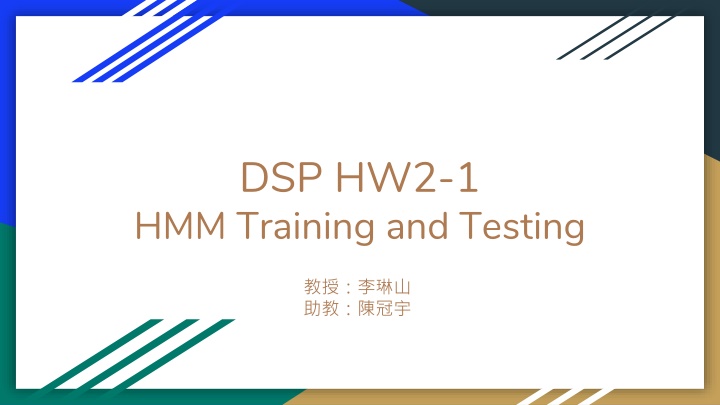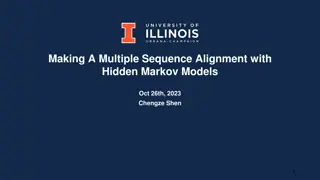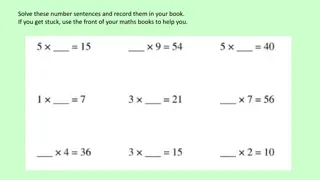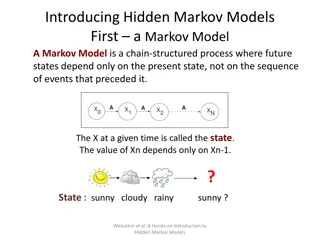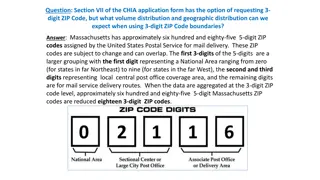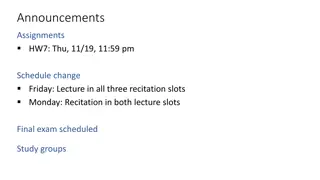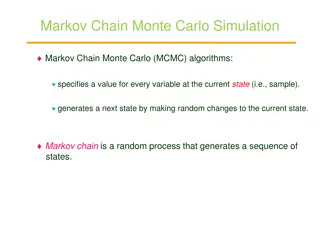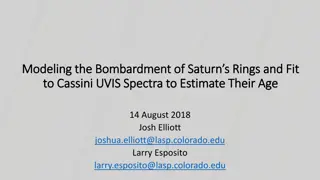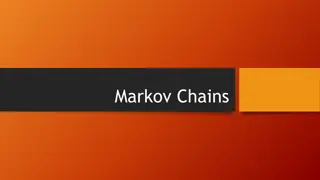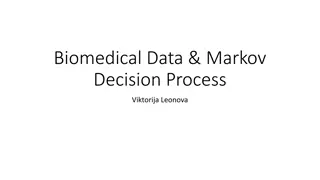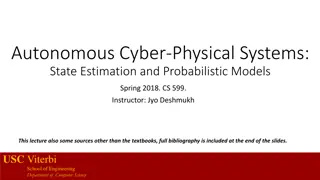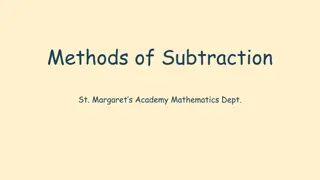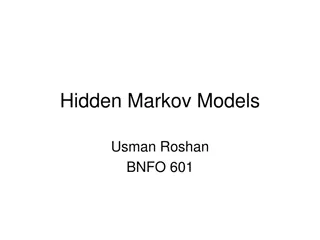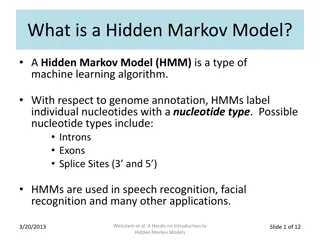Digit Recognizer Construction Using Hidden Markov Model Toolkit
Construct a digit recognizer using monophone models and Hidden Markov Toolkit (HTK). Learn about feature extraction, training flowcharts, and initializing model parameters. Utilize provided resources for training data, testing data, and scripts to build an efficient recognizer.
Download Presentation

Please find below an Image/Link to download the presentation.
The content on the website is provided AS IS for your information and personal use only. It may not be sold, licensed, or shared on other websites without obtaining consent from the author.If you encounter any issues during the download, it is possible that the publisher has removed the file from their server.
You are allowed to download the files provided on this website for personal or commercial use, subject to the condition that they are used lawfully. All files are the property of their respective owners.
The content on the website is provided AS IS for your information and personal use only. It may not be sold, licensed, or shared on other websites without obtaining consent from the author.
E N D
Presentation Transcript
DSP HW2-1 HMM Training and Testing
Outline 1. Introduction 2. Hidden Markov Model Toolkit (HTK) 3. Homework Problems 4. Submission Requirements
Introduction Construct a digit recognizer - monophone ling | yi | er | san | si | wu | liu | qi | ba | jiu Free tools of HMM: Hidden Markov Toolkit (HTK) http://htk.eng.cam.ac.uk/ Training data, testing data, scripts, and other resources all are available on http://speech.ee.ntu.edu.tw/DSP2017Autumn/
Feature Extraction - HCopy Convert wave to 39 dimension MFCC. -C lib/hcopy.cfg input and output format parameters of feature extraction Chapter 7 - Speech Signals and Front-end Processing -S scripts/training_hcopy.scp a mapping from Input file name to output file name speechdata/training/ N110022.wav MFCC/training/ N110022.mfc
Initialize model - HCompV Compute global mean and variance of features -C lib/config.cfg set format of input feature (MFCC_Z_E_D_A) -o hmmdef -M hmm set output name: hmm/hmmdef -S scripts/training.scp a list of training data lib/proto a description of a HMM model, HTK MMF format you can modify the Model Format here (# states) !
Initial MMF Prototype MMF: HTKBook chapter 7
hmm/models Initial HMM bin/macro Produce MMF contains vFloor bin/models_1mixsil add silence HMM hmm/hmmdef
Adjust HMMs - HERest Basic problem 3 for HMM Given O and an initial model =(A,B, ), adjust to maximize P(O| )
Adjust HMMs - HERest Adjust parameters to maximize P(O| ) one iteration of EM algorithm run this command three times => three iterations I labels/Clean08TR.mlf set label file to labels/Clean08TR.mlf -o lib/models.lst a list of word models (liN ( ), #i ( ), #er ( ), jiou ( ), sil)
Add SP Model Add sp (short pause) HMM definition to MMF file hmm/hmmdef
Modify HMMs - HHEd lib/sil1.hed a list of command to modify HMM definitions lib/models_sp.lst a new list of model (liN ( ), #i ( ), #er ( ), jiou ( ), sil, sp)
Modification of Models You can modify # of Gaussian mixture here. This value tells HTK to change the mixture number from state 2 to state 4. If you want to change # state, check lib/proto. You can increase # Gaussian mixture here.
Training Flowchart Hint Increase mixtures little by little !
Construct Word Net - HParse lib/grammar_sp regular expression easy for user to construct lib/wdnet_sp output word net the format that HTK understand
Viterbi Search - HVite -w lib/wdnet_sp input word net -i result/result.mlf output MLF file lib/dict dictionary: a mapping from word to phone sequences ling -> liN, er -> #er, . -> sic_i i, -> chi_i i
Compared With Answer - HResults Longest Common Subsequence (LCS) Ref See HTK book 3.2.2 (p. 33)
Report - Part 1 (40%) - Run Baseline 1. Download HTK tools and homework package 2. Set PATH for HTK tools set_htk_path.sh 3. Execute (bash shell script) 01_run_HCopy.sh 02_run_HCompV.sh 03_training.sh 04_testing.sh 4. You can find accuracy in result/accuracy the baseline accuracy is 74.34% 5. Put the screenshot of your result on the report.
Useful tips 1. To unzip files unzip XXXX.zip tar -zxvf XXXX.tar.gz 2. To set path in set_htk_path.sh PATH=$PATH: ~/XXXX/XXXX 3. In case shell script is not permitted to run chmod 744 XXXX.sh
Report - Part 2 (40%) - Improve Accuracy Acc > 95% for full credit ; 90~95% for partial credit and put the screenshot of your result on the report. 03_training.sh, mix2_10.hed... proto
Part 2 - Attention 1 Executing 03_training.sh twice is different from doubling the number of training iterations. To increase the number of training iterations, please modify the script, rather than run it many times.
Part 2 - Attention 2 Every time you modified any parameter or file, you should run 00_clean_all.sh to remove all the files that were produced before, and restart all the procedures. If not, the new settings will be performed on the previous files, and hence you will be not able to analyze the new results. (Of course, you should record your current results before starting the next experiment.)
Report - Part 3 (30%) Write a report describing your training process and accuracy. Number of states, Gaussian mixtures, iterations, How some changes effect the performance Other interesting discoveries Well-written report may get +10% bonus.
Submission Requirements 4 shell scripts your modified 01~04_XXXX.sh 1 accuracy file with only your best accuracy (The baseline result is not needed.) proto, mix2_10.hed your modified hmm prototype and file which specifies the number of GMMs of each state 1 report (in PDF format) the filename should be hw2-1_bXXXXXXXX.pdf (your student ID) Put above 8 files in a folder (named after your student ID), and compress into 1 zip file and upload it to Ceiba.
If you have any problem Check for hints in the linux and shell scripts. ex Check the HTK book. Ask friends who are familiar with Linux commands or Cygwin. (link how to HTK on Cygwin) Contact the TA : email ntudigitalspeechprocessingta@gmail.com title: [HW2-1] bxxxxxxxx (your student number)
